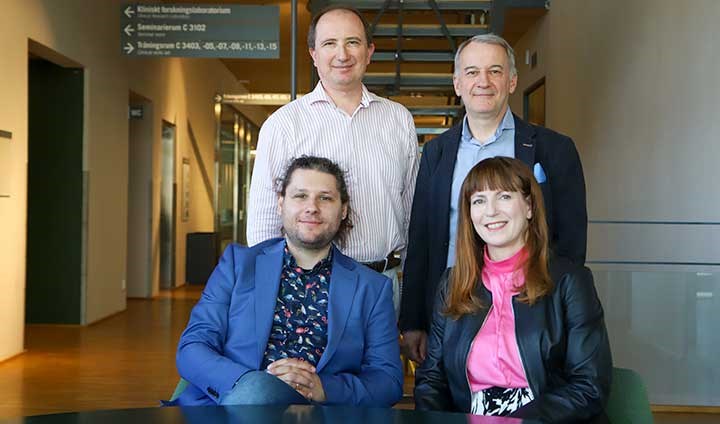A simple blood sample indicates how serious a head trauma is

Six of the authors of the article from Örebro University: Matej Orešič and András Büki, Ilias Thomas and Tuulia Hyötyläinen. Tim Sinioja och Daniel Duberg are not in the picture.
A simple blood sample to diagnose patients with traumatic brain injury – an innovation enabled by researchers at Örebro University. In a new study, reported in Nature Communications, scientists have identified biomarkers in the blood that indicate how serious a head trauma is.
The study is funded by the Swedish Research Council and started in 2018. The researchers at Örebro University have built knowledge and an infrastructure. This is the first study to be published, but there will be more.
Read the article in Nature Communications
A fall, a road traffic accident or assault. Those are the most common causes of traumatic brain injury. Over 140 million people around the world are living with symptoms of head trauma. Those affected are primarily under the age of 40.
“Having an accident early in life can have major consequences. Better and safer diagnosis is therefore vital,” says Matej Orešič, professor of medicine at Örebro University.
In Örebro, researchers have worked on a method that does not require a surgical procedure. They have used blood samples collected by researchers, all part of an EU project, in 20 European countries – the largest study of its kind.
With the help of metabolomics – a way of using chemical analysis to extract information about thousands of small molecules – the Örebro researchers have identified biomarkers that can be linked to traumatic brain injury.
“As a result, we’re able to categorise the injuries more clearly. It’s cost-effective, not to mention simpler and safer for the patient,” says András Büki, professor of medicine at Örebro University.
Today, traumatic brain injury is divided into three categories, from mild to severe, and there are no reliable methods to rule out acute brain injury.
“To us, the acute phase is the most critical, and with the help of these biomarkers, we can assess how severe the injury is – and what’s more, we can arrive at a prognosis of the outcome for the patient going forward,” says András Büki, previously responsible for organising neuro-surgical care for patients in the Pecs region, with a population of one million, in Hungary.
“It may be that in some cases, even a milder concussion can cause long-term and serious trauma. And we’ll be able to see that by taking a blood sample,” says Matej Orešič.
People sustaining milder brain injury often experience tiredness, memory loss and problems with their balance even long after the accident. This applies not least to athletes who often sustain repeated concussions, and these may have major consequences.
“Currently, we have no tools for a straightforward assessment of when an athlete can go back to training or competing following a concussion. Not everyone can get an MRI scan – but a blood sample would enable us to increase testing capacity,” says András Büki.
“If we look at heart patients, there are significantly more tools available with which to assess them. We hope that we’re now on a path towards better treatment – and research – also for neuro patients,” says András Büki.
Text and photo: Linda Harradine
Translation: Charlotta Hambre-Knight
Publication:
Ilias Thomas, Alex M. Dickens, Jussi P. Posti, Endre Czeiter, Daniel Duberg, Tim Sinioja, Matilda Kråkström, Isabel R. A. Retel Helmrich, Kevin K. W. Wang, Andrew I. R. Maas, Ewout W. Steyerberg, David K. Menon, Olli Tenovuo, Tuulia Hyötyläinen, András Büki, Matej Orešič; CENTER-TBI Participants and Investigators. Serum metabolome associated with severity of acute traumatic brain injury. Nature Communications (2022). Doi: 10.1038/s41467-022-30227-5
